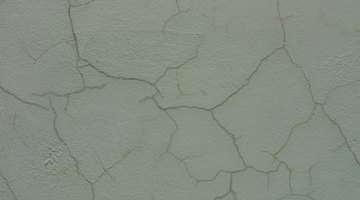What Is Latex Cement?
Do-it-yourselfers have a wide array of products available for home repairs. Concrete repairs around the home are easier than ever with pre-mixed concrete patching materials and specialized cements for a variety of uses.

Latex cement offers particular advantages over other cement patching compounds, such as increased flexibility and fast drying time. Latex cement is used similarly to other concrete patching materials.
What's in Latex Cement?
Latex cement is composed of Portland cement, sand and a latex binder, according to the Home Depot website. Latex cements come in a many forms. Some latex cements are dry and must be mixed with water. Other mixtures are premixed and can be used directly from the container. Other types require that the liquid latex be mixed with the dry cement immediately before use.
Uses for Latex Cement
Latex cements have many uses, including for concrete resurfacing, tuck pointing, patching cracks or pits in concrete and installing tile. Thicknesses greater than ¼ inch require multiple coats of latex cement. You should allow the surface to dry between coats, according to the JETomes website. Latex cement can be applied with a broom, brush, spray or trowel. The surface is generally usable after six to eight hours of drying time.
Advantages of Latex Cement
Latex has been added to cement for many reasons for more than 70 years. Today’s latex cement uses a number of specific polymers to provide more flexibility, greater water resistance, less shrinkage and a more durable patch for concrete surfaces. These advantages make latex cement a widely used material for do-it-yourself projects. Latex cement also has superior adhering power, which makes it a good choice for tiling applications. This bonding capability is particularly advantageous for use on concrete flooring materials. Latex cement materials are resistant to salt, as well as many chemical compounds. This quality makes latex cement advantageous for concrete flooring that is often in contact with chemical substances, such as automotive paints and solvents and other materials.
Problems With Latex Cement
The manufacture of latex cements is more complex than the manufacture of traditional concrete mixtures. As a result, latex cement is generally costlier. The latex component can leach out of the the concrete under certain conditions. This residue is different than common concrete efflorescence that can be removed with sulfuric acid. Latex leaching must be removed with a solvent seal stripper, according to the Ceramic Tile Institute of America website.
The Drip Cap
- Do-it-yourselfers have a wide array of products available for home repairs.
- Latex cement offers particular advantages over other cement patching compounds, such as increased flexibility and fast drying time.
- Some latex cements are dry and must be mixed with water.
- Thicknesses greater than ¼ inch require multiple coats of latex cement.
- These advantages make latex cement a widely used material for do-it-yourself projects.
- As a result, latex cement is generally costlier.
References
Photo Credits
- Photos.com/Photos.com/Getty Images
- Photos.com/Photos.com/Getty Images
More Articles



